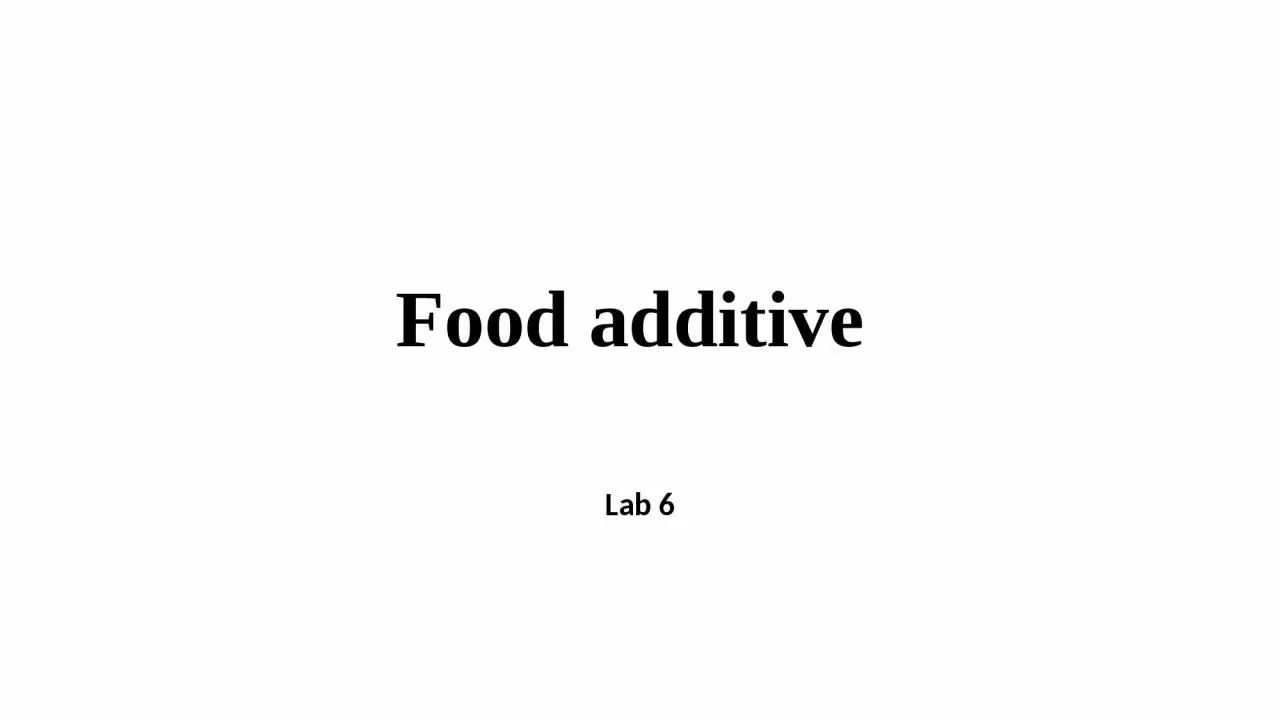

Additives Substances that are added to food to maintain or improve the safety freshness taste texture to extend its shelf life are known as food additives Some food additives have been in use for centuries for preservation such as salt in meats sugar in marmalade ID: 1048465
Download Presentation The PPT/PDF document "Food additive Lab 6 Food" is the property of its rightful owner. Permission is granted to download and print the materials on this web site for personal, non-commercial use only, and to display it on your personal computer provided you do not modify the materials and that you retain all copyright notices contained in the materials. By downloading content from our website, you accept the terms of this agreement.
1. Food additive Lab 6
2. Food AdditivesSubstances that are added to food to maintain or improve the safety, freshness, taste, texture, to extend its shelf life are known as food additives. Some food additives have been in use for centuries for preservation – such as salt (in meats), sugar (in marmalade).Some of these substances have been associated with adverse health effects and should be avoided, while others are safe and can be consumed with minimal risk.Food additives are substances that become part of a food product when they are added during the processing or making of that food.
3. 1-Direct" food additives are often added during processing to: Add nutrientsHelp process or prepare the foodKeep the product freshMake the food more appealingDirect food additives may be man-made or natural.Natural food additives include: Herbs or spices to add flavor to foodsVinegar Salt
4. 2- Indirect" food additives are substances that may be found in food during or after it is processed. They were not used or placed in the food on purpose. These additives are present in small amounts in the final product.Food additives are classified on the basis of their functional use and are grouped as:Preservatives, Colours, Acidity Regulators, Antioxidants, Antifoaming Agents, Artificial sweetener, Flavours , Modified Starches , Stabilizers
5. The purpose of Food preservativesFood Preservatives are chemical substances that are added to food to help: prevent spoiling improve appearance and/or maintain the food's nutritional quality.
6. Mechanisms of the action of preservation of foods:1. interfering with genetic material.2. interfering with enzymetic activity and proteins.3. interfering with cell wall synthesis.4.Binding to essential nutrients.5. Act as antioxidant (Block oxidation).
7. The common preservatives added to milk are:i) Formalinii) Boric acid and boratesiii) Benzoic acid and sodium benzoateiv) Salicylic acidv) Mercuric chloridevi) Potassium chromatevii) Hydrogen peroxide
8. Formalin can be detected by three tests:Hehner testHehner-Fulton testChromotropic test.
9. 1-Hehner TestHehner test is a very simple and quick test for detecting formalin. It can be detected with concentrated sulphuric acid in the presence of an oxidizing agent FeCl3 . Take 5 ml sample of milk in a test tube and gently add 2 ml concentrated sulphuric acid (H2SO4) containing a trace of FeCI3 . Care should be taken that while adding acid it forms a separate layer at the bottom of the tube. The acid should not mix with milk
10. 2- Chromotropic Acid TestChromotropic acid test is a colour reaction test with formalin. In the presence of formaldehyde chromotropic acid develops a purple colour. The coloured reaction of Chromotropic acid test is due to reaction between chromotropic acid and formalin. Chromotropic acid solution-is prepared as a saturated solution of chromotropic acid(1,8- dehydroxy napthalene-3, 6-disulphonic acid). The solution is prepared by stirring 0.5 g of chromotropic acid in 100 ml 72% H2SO4 (150 ml concentrated H2SO4 in 100 ml water-mixed in cold). The solution is straw yellow in colour.
11. • 5 ml reagent and 1 ml milk distillate is taken in test tube. Distillate is prepared from H3PO4 acidified milk.• The test tube is placed in a boiling water and the developed colour is noted.• Development of light to deep purple colour indicates the presence of formalin.The colour intensity depends upon the amount of formalin present in sample.